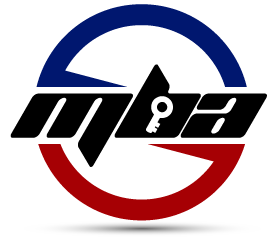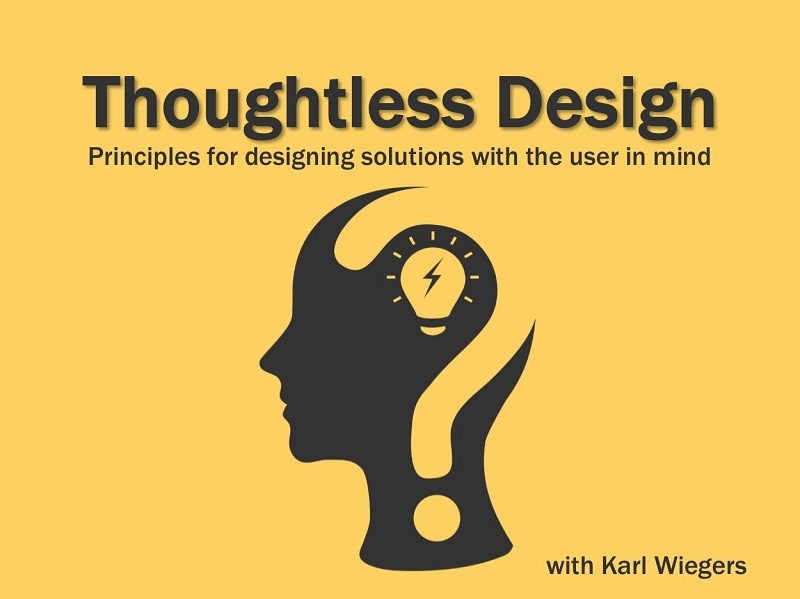Author and thought leader Karl Wiegers shares principles and lessons he has learned from poor designs and what you can do to develop solutions that create a great user experience.
Show Notes
We’re all experienced products that are confusing, difficult to use, and cause frustration. Author Karl Wiegers has pulled together a collection of products with a thoughtless design and created a set of design principles and lessons to help us create solutions with the user in mind.
If the solutions that we create aren’t usable, they’re not valuable to our customers.
Design Lessons
Karl’s first design lesson is to focus the design on usage, not on product features. Studies show that a high percentage of the features that are included in software packages are rarely used.
Let’s think about what people want to do with the product and the environment in which they’re going to be using it. Then we can design the product to make it easier for users to get the job done. Let’s understand the disease before we come up with a cure.
A second lesson is that design demands iteration. You’re not going to get the design right on your first try. You have to iterate. You have to sneak up on approaching a better design with each cycle until you have a design that’s good enough to satisfy the requirements and usability.
You can iterate at multiple levels. You can iterate with each product release similar to the iPhone. When you iterate at that level, you may also get a lot of new bugs and increase complexity of the product.
Making a product, marketing it, then seeing how people like it and making another try in a year is an expensive way to iterate. We want to iterate as cheaply as possible as many times as we can, and that requires doing things with prototypes and mockups. We can have an incremental growth of the level of precision and detail with the prototypes.
The third lesson is we need to involve real users whenever possible. If you’re iterating on a design, how do you know what to change on your next cycle to make it better? Ideally, you’ll have some user representatives that are working with you; perhaps working with a prototype or a mockup under realistic usage conditions, as we can come up with a design. The users are going to show you things and tell you things that you just don’t get in the design lab.
Sometimes you may not have real users available. You might have to work with user surrogates, but whenever possible, there’s just no substitute for having real people work with something that’s similar to the real product and tell you all the reasons why you’re not there yet.
Fundamental Design Principles
There are nine design principles in Karl’s book that are fundamental to good design. The design principles include:
- Make the product easy and obvious to use: The product should provide visual cues to the user to make the product easy and obvious to use.
- Make it hard to make a mistake: The product should be designed in a way that makes it hard to make a mistake, or at least have the user verify their intentions before taking a step that potentially could be a mistake.
- Design for the user’s convenience: Think about what the user is trying to do and create a design that allows them to get the job done. Avoid designing for the business’s convenience at the expense of the user.
Remember that thoughtful design is something that makes it hard for users to make mistakes, doesn’t waste the user’s time, and is for the user’s convenience. Let’s try to detect unsatisfied preconditions and erroneous inputs as early as possible in the test sequence so the user doesn’t waste time on a task they can’t complete.
Listen to the full episode to get more of Karl’s tips and advice on building products with the customer’s usability in mind.
| Your Homework As a Business Analyst, Product Owner, or designer, let’s not make something and then have people tell us all the stuff we did wrong and why they hate it. Instead, try to satisfy the nine design principles from the outset. As a consumer, it helps us think more carefully about what features we’re looking for when we’re considering possible products that we might buy. What are the things that are important to me as a user before I buy it, take it home and saying that’s not what I was hoping was going to be? On a broader scale, we should all think more about the properties and characteristics and capabilities that we’re looking for before we put down our money. |
Links Mentioned in This Episode
- Karl’s website – https://karlwiegers.com/
- The Thoughtless Design of Everyday Things book site: http://thoughtless-design.com/

Karl Wiegers
Karl Wiegers is an independent consultant, author, speaker, and thought leader in the project community. His books on software requirements are considered required reading for Business Analysts and Project Managers. As a consultant and trainer, Karl has worked with more than 100 companies and government organizations of all types, helping them improve the effectiveness and efficiency of their software development activities.
Karl’s most recent book is The Thoughtless Design of Everyday Things
Thank you for listening to the program
To get more valuable content to enhance your skills and advance your career, you can subscribe on iTunes.
Also, reviews on iTunes are highly appreciated! I read each review and it helps keep me motivated to continue to bring you valuable content each week.



